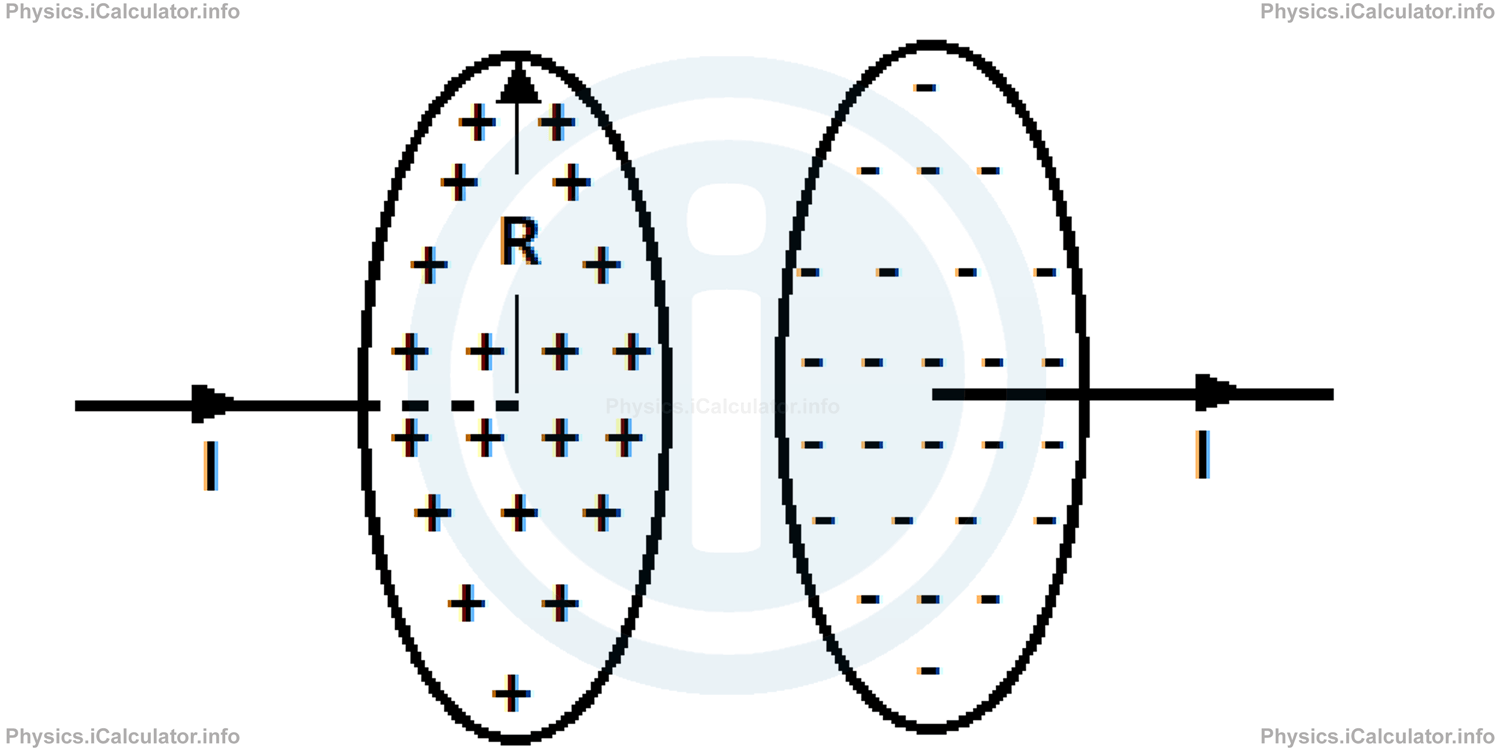Menu
Physics Lesson 16.18.3 - Displacement Current
Please provide a rating, it takes seconds and helps us to keep this resource free for all to use
Welcome to our Physics lesson on Displacement Current, this is the third lesson of our suite of physics lessons covering the topic of Maxwell Equations, you can find links to the other lessons within this tutorial and access additional physics learning resources below this lesson.
Displacement Current
When analysing the equation derived from the Ampere-Maxwell Law
it is obvious that the expression
must have the dimension of current. This current is known as the "displacement current, id", despite no current is really being displaced. Thus, the above equation becomes
Let's consider again the charging capacitor of the previous section, shown in the figure below.

Let's find a way to relate the real current I that is used to charge the capacitor plates to the fictitious displacement current Id which is associated to the change in the electric field between the plates.
From the Gauss Law for electric field
we obtain for the charge Q on the plates at any time:
where E is the magnitude of electric field between the plates at that time.
Differentiating the above equation with respect to time, we obtain for the real current I which charges the capacitor:
As for the displacement current Id, we have
= ε0 ∙ d(E ∙ A)/dt
= ε0 ∙ A ∙ dE(t)/dt
As you see, we obtained the same expression for the displacement current to the expression obtained for the real current. Thus, we can consider the fictitious displacement current Id simply as a continuation of the real current I from one plate of capacitor to the other plate flowing through the gap between plates. Although no charge actually moves across the gap between the plates, the idea of the fictitious current Id can help us to quickly find the direction and magnitude of an induced magnetic field as we will see in the next paragraph.
You have reached the end of Physics lesson 16.18.3 Displacement Current. There are 5 lessons in this physics tutorial covering Maxwell Equations, you can access all the lessons from this tutorial below.
More Maxwell Equations Lessons and Learning Resources
Whats next?
Enjoy the "Displacement Current" physics lesson? People who liked the "Maxwell Equations lesson found the following resources useful:
- Displacement Current Feedback. Helps other - Leave a rating for this displacement current (see below)
- Magnetism Physics tutorial: Maxwell Equations. Read the Maxwell Equations physics tutorial and build your physics knowledge of Magnetism
- Magnetism Revision Notes: Maxwell Equations. Print the notes so you can revise the key points covered in the physics tutorial for Maxwell Equations
- Magnetism Practice Questions: Maxwell Equations. Test and improve your knowledge of Maxwell Equations with example questins and answers
- Check your calculations for Magnetism questions with our excellent Magnetism calculators which contain full equations and calculations clearly displayed line by line. See the Magnetism Calculators by iCalculator™ below.
- Continuing learning magnetism - read our next physics tutorial: Introduction to Magnetism
Help others Learning Physics just like you
Please provide a rating, it takes seconds and helps us to keep this resource free for all to use
We hope you found this Physics lesson "Maxwell Equations" useful. If you did it would be great if you could spare the time to rate this physics lesson (simply click on the number of stars that match your assessment of this physics learning aide) and/or share on social media, this helps us identify popular tutorials and calculators and expand our free learning resources to support our users around the world have free access to expand their knowledge of physics and other disciplines.
Magnetism Calculators by iCalculator™
- Angular Frequency Of Oscillations In Rlc Circuit Calculator
- Calculating Magnetic Field Using The Amperes Law
- Capacitive Reactance Calculator
- Current In A Rl Circuit Calculator
- Displacement Current Calculator
- Electric Charge Stored In The Capacitor Of A Rlc Circuit In Damped Oscillations Calculator
- Electric Power In A Ac Circuit Calculator
- Energy Decay As A Function Of Time In Damped Oscillations Calculator
- Energy Density Of Magnetic Field Calculator
- Energy In A Lc Circuit Calculator
- Faradays Law Calculator
- Frequency Of Oscillations In A Lc Circuit Calculator
- Impedance Calculator
- Induced Emf As A Motional Emf Calculator
- Inductive Reactance Calculator
- Lorentz Force Calculator
- Magnetic Dipole Moment Calculator
- Magnetic Field At Centre Of A Current Carrying Loop Calculator
- Magnetic Field In Terms Of Electric Field Change Calculator
- Magnetic Field Inside A Long Stretched Current Carrying Wire Calculator
- Magnetic Field Inside A Solenoid Calculator
- Magnetic Field Inside A Toroid Calculator
- Magnetic Field Produced Around A Long Current Carrying Wire
- Magnetic Flux Calculator
- Magnetic Force Acting On A Moving Charge Inside A Uniform Magnetic Field Calculator
- Magnetic Force Between Two Parallel Current Carrying Wires Calculator
- Magnetic Potential Energy Stored In An Inductor Calculator
- Output Current In A Transformer Calculator
- Phase Constant In A Rlc Circuit Calculator
- Power Factor In A Rlc Circuit Calculator
- Power Induced On A Metal Bar Moving Inside A Magnetic Field Due To An Applied Force Calculator
- Radius Of Trajectory And Period Of A Charge Moving Inside A Uniform Magnetic Field Calculator
- Self Induced Emf Calculator
- Self Inductance Calculator
- Torque Produced By A Rectangular Coil Inside A Uniform Magnetic Field Calculator
- Work Done On A Magnetic Dipole Calculator